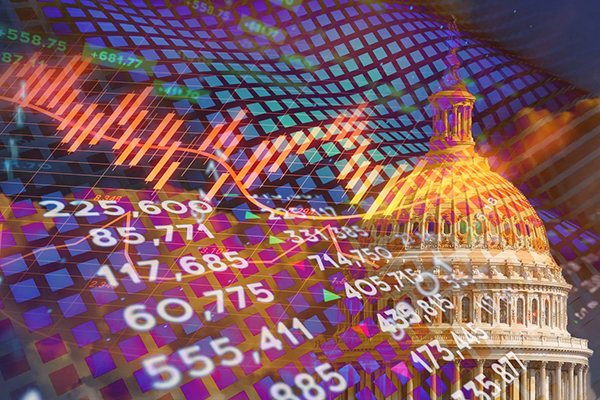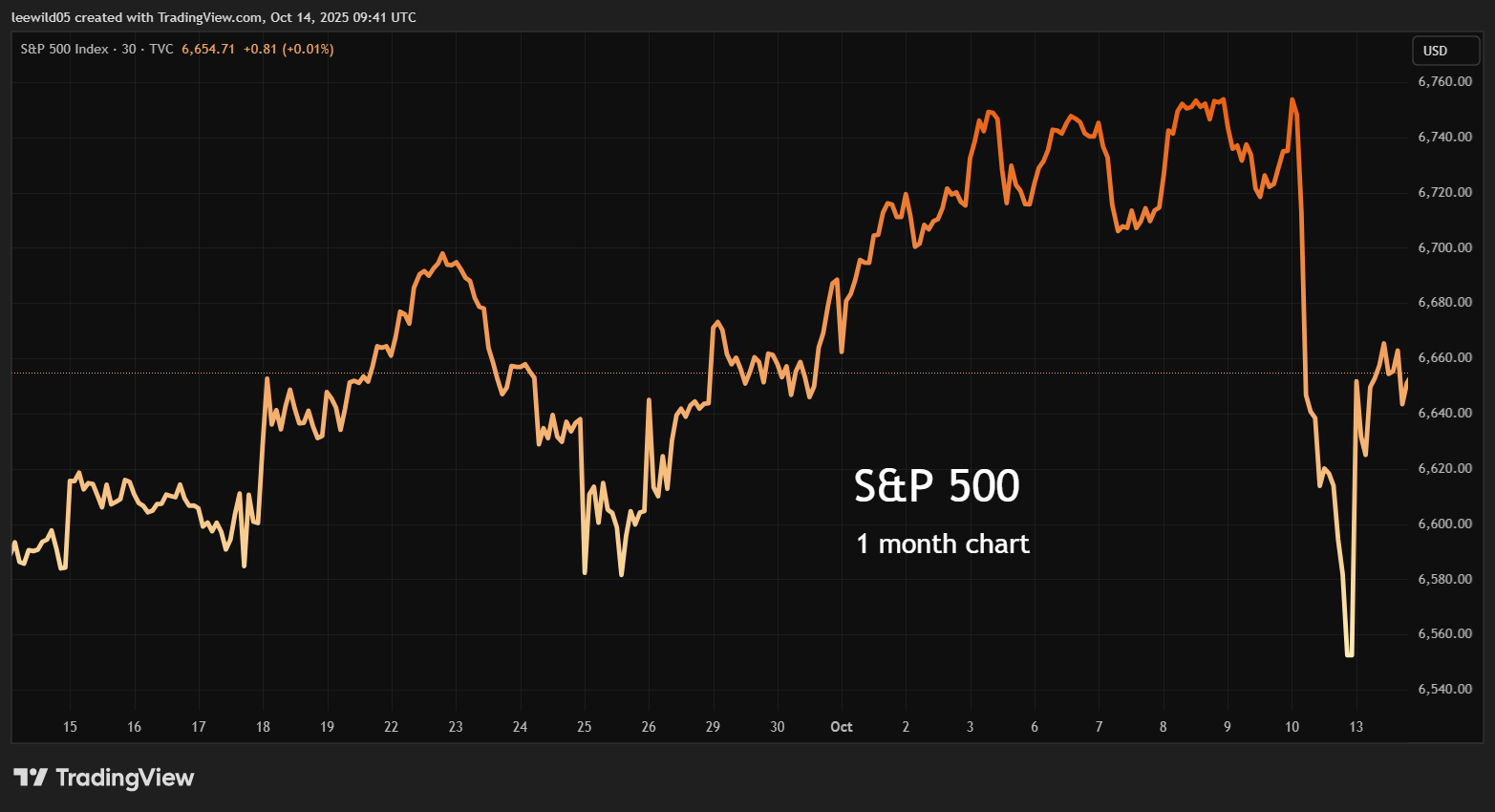Stockwatch: is recent bolt of panic a warning sign?
After a sharp increase in market volatility, analyst Edmond Jackson looks at the causes, potential resolutions and the implications for investors.
14th October 2025 11:23
by Edmond Jackson from interactive investor

So, “buy the drop” is once again affirmed and it is back to the races. Last Friday saw the sharpest drop in US shares since the aftermath of “Liberation Day” in April, with the S&P 500 down 2.5%.
Far from the US-China trade relationship being under control and tempered, it appeared to suddenly blow up, with China aggressively weaponising rare earth materials and magnets on which it enjoys a near-global monopoly.
- Invest with ii: SIPP Account | Stocks & Shares ISA | See all Investment Accounts
“Rare earths” are actually not so much rare as difficult to extract. China operates 70% of rare earth mining, 90% of separation and processing, and 93% of magnet manufacturing. While the US has a significant rare earth mining industry, it lacks processing facilities.
China’s commerce ministry declared very strict export controls from 1 December, which it’s hard to imagine wasn’t considered inflammatory by the US, given that these materials are crucial to consumer electronics, cars and military equipment. Many US tech companies are reliant on such Chinese imports given that there is only one manufacturer of rare earth magnets in the US – Noveon Magnetics Inc, in Texas.
President Donald Trump responded with a 100% tariffs threat on all Chinese imports, plus new export controls on critical software products from 1 November. Beijing reportedly told Washington on Sunday that it will retaliate and blamed the US for raising trade tensions.
- Insider: Rolls-Royce director makes new £485k trade
- Rethinking exposure to US? The domestic shares the pros are buying
Once again, Trump appeared to chicken out, posting on his Truth Social account: “Don’t worry about China, it will all be fine! Highly respected President Xi just had a bad moment. He doesn’t want Depression for his country, and neither do I. The USA wants to help China, not hurt it.”
In a broad-based rally yesterday, the S&P 500 rebounded 1.6%, with 80% of constituents rising. The small-cap Russell 2000 jumped 2.5% after Friday’s 3% fall. Crisis averted?

Source: TradingView. Past performance is not a guide to future performance.
How willing is China to soften its stance?
The export restriction of rare earths and magnets was clearly well thought-out and extensive, hence backtracking would involve loss of face which is so critical in Asia.
This latest salvo from China turns the tables on US tactics. For example, in 2020 China’s Huawei Corporation was denied access to US semiconductors on the grounds that the technology could be used by the Chinese military. Provisions under a “foreign direct product rule” were used to try to limit Chinese technological development. It is still highly provocative of President Trump to target the US defence sector with an import ban.
- Shares for the future: this new stock replaces a FTSE 250 firm
- Sign up to our free newsletter for investment ideas, latest news and award-winning analysis
Any magnet containing mere trace amounts of Chinese-sourced rare earth materials requires Beijing’s export approval. The US is struggling to scale up defence production – compromised by higher technology needs – and China is estimated to be developing an advanced weapons platforms and equipment at a rate five to six times faster than the US.
This capability gap is especially relevant to a superpower arms race over the Indo-Pacific region that seems a key priority for the Trump administration. Part of its motivation in securing peace deals between Russia/Ukraine and Israel/Palestine is to prioritise the Pacific.
Wall Street’s sense of relief at Trump’s Sunday social media post is therefore superficial when you consider what’s at stake, which effectively requires China to also back down.
Consolidating position in rare earths and magnets
China’s latest stance marks a sharp escalation since December 2023 controls on rare earth exports were tightened in April 2025 in retaliation against Trump’s new tariffs on Chinese goods. Negotiations made only modest progress in May: a 90-day tariff truce meant US companies were removed from China’s trade blacklist and their rare earth supplies restored.
Yet China’s resolve was shown by delaying issuance of export licences despite not formally abandoning the deal, and Trump accused Beijing of backtracking. Then, in June, a new trade framework was struck, which it appears China now seeks to decry.
Having dramatically raised the stakes, it seems hard to envisage China backing down on the export ban in relation to the defence industry, which is what really counts in US/China diplomacy, near-term.
- Watch our video: the US shares we’ve bought, and taking some tech profits
- eyeQ: Glencore shares - chase rally or keep powder dry?
In the medium term, the US can possibly improve its rare-earth processing capability, but how many years’ advantage would that cede to China in the Pacific arms race?
Tough new regulations appear specifically timed ahead of a meeting due between the two presidents later this month, likely to address the US/China trade truce from May that is due to expire in mid-November.
Trump’s apparent chickening out last Sunday might conceivably embolden China at least to stick to its guns for now.
Three US listed companies most exposed
At least these highly exposed stocks are not widely owned.
Applied Materials Inc (NASDAQ:AMAT) supplies equipment and services for semiconductor manufacture for consumer electronics,its tools relying on ultra-clean environments served by rare earth magnets. Its shares fell 8% on Friday but recovered 4% yesterday. Hardly catastrophic, and in line with the kind of volatility you’d expect from tech shares anyway.
Lam Research Corp (NASDAQ:LRCX) has rallied the most this year, up around 90%. Its stock fell 11% on Friday but recovered 5% yesterday where it trades on a circa 33x trailing price/earnings (PE) ratio. This company supplies wafer fabrication to the semiconductor industry.
KLA Corp (NASDAQ:KLAC) is in metrology and inspection systems, and its extreme precision depends on rare earth magnets. Shares have rallied 60% this year. On Friday, they fell 8% then recovered 4% yesterday to a PE around 34x.
Responses are thus measured so far, considering that these are essentially high-rated shares most in the firing line. A potential knock-on effect to semiconductor supply for big tech generally is key if the trade stand-off festers.
Scope for conflation of various major risks
Call me pessimistic, but looking past the knee-jerk reactions of Wall Street, this particular aspect of US-China trade dispute looks very difficult to compromise – unless China backs down at the risk of being made to look foolish.
Trump’s latest social media post doesn’t square with his administration needing to take the US-China arms race seriously.
The US government shutdown is also extending into a third week, with a major payrolls deadline this Wednesday. As I’ve explained in a previous piece, American politicians seem more dug into their positions than in previous shutdowns, hence a financial markets’ tantrum might be what it takes to force a compromise.
Another role in this drama is the governor of the Bank of England, as chair of the Financial Stability Board, which is an international body that monitors and makes recommendations about the global financial system. Andrew Bailey’s letter to G20 finance ministers – warning of a stock market crash due to over-optimistic markets versus spiralling sovereign debt – has received attention.
The International Monetary Fund (IMF) joined in last week, similarly warning of a “sharp contraction” in markets due to the boom in AI-related shares.
Potential exists for an infection point,George Soros might say (whose long/short trading career was largely based on identifying and exploiting such).
More positively, such fears are well articulated, whereas last Friday underlined how it’s the surprise element causing most damage.
US bank sector results and what they tell us about both the US and global economy will be significant to overall sentiment.
If market participants are rational, they will be looking to a Trump/Xi meeting to resolve a crux issue in 21st-century superpower rivalry. It looks like the toughest stand-off with the widest ramifications, so far.
Edmond Jackson is a freelance contributor and not a direct employee of interactive investor.
These articles are provided for information purposes only. Occasionally, an opinion about whether to buy or sell a specific investment may be provided by third parties. The content is not intended to be a personal recommendation to buy or sell any financial instrument or product, or to adopt any investment strategy as it is not provided based on an assessment of your investing knowledge and experience, your financial situation or your investment objectives. The value of your investments, and the income derived from them, may go down as well as up. You may not get back all the money that you invest. The investments referred to in this article may not be suitable for all investors, and if in doubt, an investor should seek advice from a qualified investment adviser.
Full performance can be found on the company or index summary page on the interactive investor website. Simply click on the company's or index name highlighted in the article.
Disclosure
We use a combination of fundamental and technical analysis in forming our view as to the valuation and prospects of an investment. Where relevant we have set out those particular matters we think are important in the above article, but further detail can be found here.
Please note that our article on this investment should not be considered to be a regular publication.
Details of all recommendations issued by ii during the previous 12-month period can be found here.
ii adheres to a strict code of conduct. Contributors may hold shares or have other interests in companies included in these portfolios, which could create a conflict of interests. Contributors intending to write about any financial instruments in which they have an interest are required to disclose such interest to ii and in the article itself. ii will at all times consider whether such interest impairs the objectivity of the recommendation.
In addition, individuals involved in the production of investment articles are subject to a personal account dealing restriction, which prevents them from placing a transaction in the specified instrument(s) for a period before and for five working days after such publication. This is to avoid personal interests conflicting with the interests of the recipients of those investment articles.